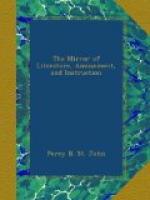[2] The dangerous passage across the bar of the Douro, and its shifting sands, are well known. The care and skill required to navigate a vessel with safety into the Douro, even during the summer, may give an idea of what the perils of this dangerous bar must be during the winter months; when the coast is exposed to the unbridled fury of the westerly winds, and to the full force of the Atlantic waves.—Portugal Illustrated, by the Rev. W. Kinsey, B.D.
[3] See Select Views of Oporto. By Lieut. Col. Batty, F.R.S., the accuracy of which may be said to extend as far as pictorial art can succeed in conveying foreign objects to our firesides. We are indebted for our Engraving to this valuable work.
To economize time and space we must quit this enchanting spot. Gondolas, like those at Venice, are used on the river, but will not suffice for our celerity. We must reach at once the point of our Engraving. The view is taken from Villa Nova, an important suburb of Oporto, on the opposite bank of the river. The city may be divided into the high and the low town. It contains, in a civil sense, five wards, or bairros, of which the Se, or cathedral hill, and the Vittoria, or height opposite to the Se, (and crowned by a church, which was founded in commemoration of a celebrated battle fought on the spot with the Moors, which terminated in their defeat and expulsion from the place,) form the town properly called Oporto; and it is possible still to trace the remains of the old wall, which formerly surrounded and defended the place. The three other quarters, San Idelfonso, Miragaya, and Villa Nova, are open. The latter is connected with the principal town by a bridge of boats, which is so badly constructed as to be scarcely able to sustain the violent power of the river when swelled by winter torrents. The Douro, like the Rhine and the Rhone, and all other rivers which flow through a rocky and often confined channel, commits at certain seasons the greatest ravages; and property to a considerable amount is annually lost at Oporto, by the irresistible force with which the river pours down and carries every thing before it. A bridge of granite has been long talked of to connect Villa Nova and Oporto, but the funds are not yet forthcoming, and the expense will be considerable.
The Engraving represents the most ancient part of the city of Oporto. We are here directly fronting the bishop’s palace, which, with the Se, or Cathedral,[4] and buildings, to the left, occupy the crest of the hill. Further left is the steeple of the church dos Clerigos, said to be the loftiest in Portugal after that of Mafra. This tower is visible from the sea at a distance of ten leagues, and serves as an important landmark for ships steering to the mouth of the Douro. It was erected in the year 1748, and is built entirely of the finest masonry, an art in which the Portuguese are almost unrivalled.




